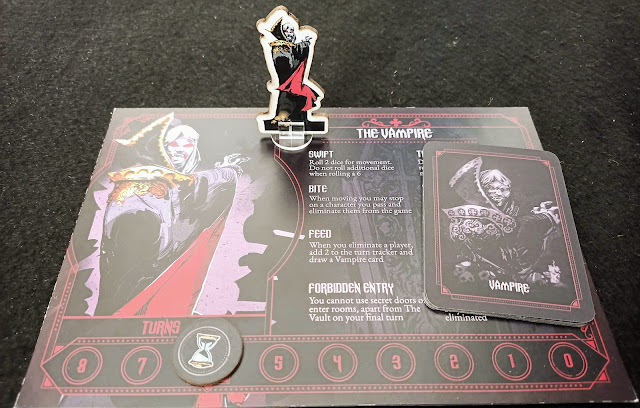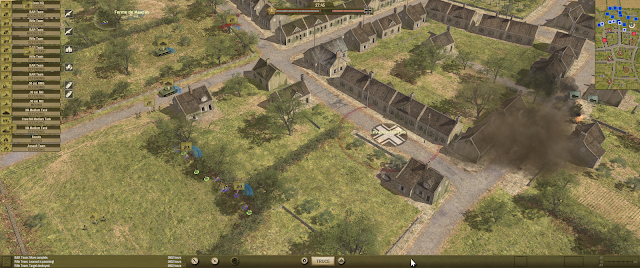UNDAUNTED: NORMANDY
from
OSPREY GAMES
This is a review I've been waiting to get to in a rather full schedule for several weeks. Undaunted: Normandy has hit a perfect niche in my wargaming collection. I've become a big fan of David Thompson's designs which have started to attract several companies' attention, as evidenced by the superb system introduced in DVG's Pavlov's House reviewed on the blog some time back. This is a system perfectly designed for his follow up game, Castle Itter, soon to be released once again by DVG. However, Undaunted: Normandy takes a very different path that does have a few similarities with one of his earlier designs, War Chest.
For me, all these designs belong to the school of "design for effect" - in other words, designs that capture the atmosphere in broad brush terms with effective and easily manageable rules. This is certainly the case here with Undaunted: Normandy, a light tactical game of small squad engagements set in the early days of the Normandy landings of WWII. Using a simple system built on a modified deck-building principle, the rules can be assimilated in very quick time. For an experienced gamer the whole set of rules can be taken in more or less at a first read through, but the game is also admirably suited to the novice gamer who will benefit considerably from the programmed-learning type of presentation.
Like many games at this level the terrain is supplied by a set of double-sided tiles of very good quality, thick cardstock that cover the standard range of landscapes. Apart from the identifying number and letter used for locating the correct tiles for a given scenario, a single or double number presents the amount of cover provided by the terrain. One aspect that has caused some discussion is that there are no issues of line of sight. This certainly makes for ease of play and when you look at the tiles you can see why such rules simply would not work.
The units are an interesting combination of cards and counters. The latter are circular and of a really satisfying size and solidity. They are also what you will manoeuvre across the map, but each unit is also represented by a number of identical cards both in your current deck of cards and in a reserve display laid out in front of you.
This is one of the game's original mechanics that I'm particularly impressed by. Typically a unit will consist of its counter and up to five cards. In game turns you might like to consider these cards as the equivalent of the steps a counter might represent in a conventional hex & counter war game. However, totally different from any war game I know, a number of these "steps" will be in your play deck according to the very clear presentation in the scenario set up and later more may be introduced by using one of the abilities of each player's leader cards, either the Platoon Sergeant or one of the Squad Leaders.
Another neat idea is that these latter figures do not appear as actual counters on the map. Only your Combat units have the circular discs that move and fight for control on the map. These are grouped into three squads [lettered A, B and C] consisting mainly of basic riflemen, a couple of machine gunners, a mortar team, a sniper and a few scouts. Apart from different fighting abilities, units have a number of other differing abilities.
The scouts, for example, play an especially important role as they are the only ones that can move into an as yet unexplored new tile. In doing so, they place a scouting marker [a great binocular icon!] which then allows other units to then move onto the tile. By contrast, only riflemen have the ability to place a control marker in a scouted tiles and so it goes on.
A range of many of your troops
This creates a hugely enjoyable situation and leads to many of the agonising choices that a player has each turn, First of all, what units will you find in your four cards drawn from your deck at the beginning of a turn. Each player will then have to choose one to play face down to determine who gains the initiative and plays out their hand first. As each type of card has a number and the higher the number the more powerful the card, do you sacrifice a powerful card to get the initiative or risk your opponent going first?
Each turn you'll play all the cards in your current hand, making decisions with each card on whether to move or fire or take control of a tile. Machine gunners also have the decision whether to fire to inflict a hit or suppress, while Mortars have first to target a tile as an action, before they can fire on it, though when they do fire they have the great advantage of potentially being able to hit every unit on the tile.
Both the Platoon Leader and the Squad leaders as mentioned have the Bolster ability to bring in more cards from your Supply into your play deck for a particular unit thus allowing the possibility of activating a counter more than once.
All this and more is very clearly laid out in the rule book in a very easy to understand set of rules, while the Scenario book helps the learning process, if played through in sequence, as scenario by scenario more and more of the different units and their functions and capabilities are introduced. For an experienced gamer the first few scenarios may be a little too limited to make the best of experiences.
However, there are twelve Scenarios in total, based on historical situations which provide a good range of variety. The mixture of taking control of a specified number of location points or pinning your opponent along with the varied set ups produce a mix of intriguing puzzles for how best to achieve your goal and use your men.

Here's one of the more unusual ones where both sides begin virtually in contact from the very start. All scenarios can be played as stand alone ones or can be grouped into shorter or longer campaigns where you gain a point for every scenario won, but then total the number of casualties suffered in the course of the campaign and deduct a victory point from your score for every 10 casualties you lost. Great idea!
A typical page of Scenario details
All this is contained in a compact box, neatly compartmentalised, as you can see, but like so many useful inserts, the sections holding the cards would benefit from being just a little larger. If you sleeve your cards, as I do, they simply don't fit in and the amount of usage and shuffling in this game will make sleeving a very worthwhile practice.
This is a very small niggle set against what is in every other respect a very, very good well presented and designed game that I think deserves to find a home in any war gamers' collection. It is a first-rate game for introducing new players to the world of war games while giving more experienced gamers an exciting and rewarding dip into a light, fast, tactical bout of combat.
I hope there will be expansion decks and scenarios that take us to other celebrated WWII battlefields on the Eastern Front or Pacific with more specialised units. Personally I'd love to see a few paratroopers dropping from the skies. While hopefully waiting for just that to happen, I expect the lure of the game to encourage many of us to have a go at creating a favourite episode or two of our own!
As always many thanks to the publishers, in this case Osprey Games for kindly providing the review copy. As a celebrated publishing company of such a fantastic range of military books that's catered for so many years to my love of military history, it's great to see their development into this other major way to explore our military world.





































Follow Us